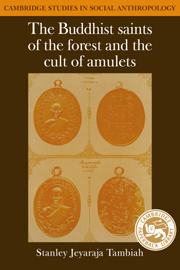Book contents
- Frontmatter
- Contents
- Acknowledgments
- Note on transcription
- 1 Introduction and manifesto
- Part I The arahant and the Path of Meditation
- Part II The hagiography of a Buddhist saint: text and context; the politics of sectarianism
- 6 The biography of a modern saint
- 7 The Buddha's life as paradigm
- 8 The ordering principles behind Buddhist saintly biography
- 9 The disciples of the Master
- 10 The biographer as exemplary forest-monk, meditator, and teacher
- 11 Sectarianism and the sponsorship of meditation
- 12 The Mahānikāi sect's propagation of lay meditation
- 13 The center–periphery dialectic: the Mahāthāt and Bovonniwet sponsorship of meditation compared
- Part III The cult of amulets: the objectification and transmission of charisma
- Part IV Conceptual and theoretical clarifications
- Notes
- Index
- CAMBRIDGE STUDIES IN SOCIAL ANTHROPOLOGY
8 - The ordering principles behind Buddhist saintly biography
Published online by Cambridge University Press: 10 December 2009
- Frontmatter
- Contents
- Acknowledgments
- Note on transcription
- 1 Introduction and manifesto
- Part I The arahant and the Path of Meditation
- Part II The hagiography of a Buddhist saint: text and context; the politics of sectarianism
- 6 The biography of a modern saint
- 7 The Buddha's life as paradigm
- 8 The ordering principles behind Buddhist saintly biography
- 9 The disciples of the Master
- 10 The biographer as exemplary forest-monk, meditator, and teacher
- 11 Sectarianism and the sponsorship of meditation
- 12 The Mahānikāi sect's propagation of lay meditation
- 13 The center–periphery dialectic: the Mahāthāt and Bovonniwet sponsorship of meditation compared
- Part III The cult of amulets: the objectification and transmission of charisma
- Part IV Conceptual and theoretical clarifications
- Notes
- Index
- CAMBRIDGE STUDIES IN SOCIAL ANTHROPOLOGY
Summary
From the time of early Buddhism to the present, biographies of famous Buddhist monks have been written, and some of these monks have been acclaimed as arahants. In general, three features have distinguished this genre of Buddhist literature. Firstly, they have followed a certain stereotype and are more noted for imitative repetition than creative innovation. Secondly, the biography served a moral, didactic purpose – the story of a saint was told not for its own sake but to edify and chasten the reader and listener. Thirdly, the expectations of a saint consist not only in his living in the most exemplary and pious fashion, but also in his performing miraculous feats, in his blessing the unfortunate and making them prosper, in his healing the sick in mind and body, in his astrological foretelling of the future, and in his giving varied signs and expressions of his holiness and compassion (mettā). Considered as a literary device and work of art, a hagiographical work is not complete without anecdotes of supramundane and transcendental powers, for without such signs of achievement a saint is not a saint, merely a virtuous man.
Now we should not credit these features only to Buddhist hagiography. Much the same could be said with few modifications of medieval Christian biographies (and perhaps analogies can be found in other religious traditions as well). For instance, biography formed an important part of the literature of medieval England, and the biographies of the Latin saints achieved maturity in form and expression.
- Type
- Chapter
- Information
- The Buddhist Saints of the Forest and the Cult of Amulets , pp. 124 - 131Publisher: Cambridge University PressPrint publication year: 1984



